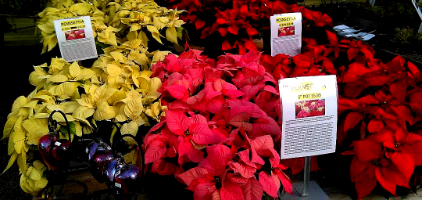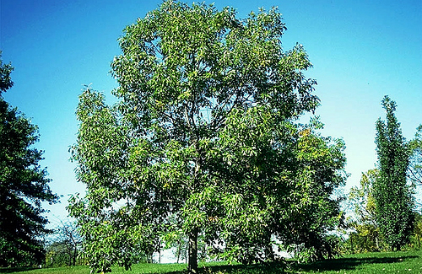When I was up in Colorado this summer I was introduced to a poster
by the late Bonnie Appleton (a horticultural educator) entitled 'How
to Kill a Tree.'
This tongue-in-cheek title was followed by an illustration of all of
the mistakes that people make when planting and caring for trees.
While many of her guidelines are universal, it got me thinking that
there are also some specific care and planting techniques that are
important to follow here in central Texas in addition to general tree
rules.
It is important to realize that a stressed tree does not always let you
know in time to save it. By the time it shows outward stress (espec-
ially for mature, established trees) it may be too late to reverse the
nternal damage.
Trees can, in some cases, take several years to show visible symp-
toms of damage (i.e. drought or compaction stress) so it is impor-
tant to treat them with respect from the start and continue to care
for them even into old age.
With oak wilt so rampant in our part of Texas, many of the actions
on this list can hasten the demise of these majestic trees. Please pay
special attention to numbers 1-4.
1. Use of weedcloth. First of all, I have grown to hate the stuff in
general, but that’s a 'rant' for another day! As for underneath trees,
it may appear that it will help to keep weeds down and moisture in,
but in reality it can help to harbor disease underneath the weedcloth
and keep the tree from breathing properly.
Also, while the tree is young, the Bermuda grass will weave its
way through the weed cloth making its removal both unpleasant
and impossible. As the tree grows larger, its natural shade will help
to eliminate many weeds without outside assistance.
2. Cross contamination through garden tools. When we move
from plant to plant and tree to tree disease can cling to our garden
pruners and saws and spread to the next plant we touch. It is impor-
tant to sterilize your tools between uses, especially if you are mov-
ing on to red or live oaks or have been working with diseased plants
to begin with.
3. Spraying herbicide around roots (especially feeder roots). It is
easy to inadvertently hit the smaller roots on the outside canopy of
a tree when applying weed killer. While a single hit may not cause
much damage, that stress can build up over time and potentially
damage the long-term growth of the tree, especially when they are
young.
4. Improper pruning (techniques and timing). It is critical that
you prune your trees at the correct angle to prevent weak joints.
Make the cut smooth and make sure you haven’t ripped that last bit
off leaving a substantial wound that can allow disease and insects in.
Prune in late winter for best results with hardening off new growth
(after most hard frosts have passed) and healing over of the wounds.
Wait until after bloom for many spring blooming trees. If you have
oak trees, the timing of your pruning is especially critical: the beetle
that helps spread oak wilt is at its least active between October and
February, so this is the optimum time.
5. Suffocating the roots with too much mulch or dirt, compaction,
concreting over, etc. Tree roots are quite sensitive to environmental
stresses, especially the outer edge of the canopy, which are known
as feeder roots.
Covering them up with too much dirt or mulch, let alone concrete
or other solid structures can cause the tree to decline and eventually
perish. Compaction of the soil from traffic (or other similar activities)
can have similar results as the soil itself suffocates the root system.
6. Forgetting to water. New trees will need supplemental moisture
for the first several years. But even larger, mature trees need special
attention sometimes too. Forgetting is easy to do when you have estab-
lished trees that have been there for countless decades.
We don’t think of them as part of the active landscape, but more as
a background for where we do our landscaping. But they are some
of the most critical to remember to water, especially during drought
to keep their stress at a minimum and ensure a quick bounce back
when Mother Nature starts to water them again herself.
7. Girdling with a weed-eater, old stake wire, etc. This is a big
issue because it can quickly kill a tree and it is easy to do if you are
not paying attention. I know I am even guilty of weed-eating just a
little too close to the trunk of that new tree trying to neaten up my
yard. It is also easy to forget that those tree stakes and wires should
be removed after the first 6 months to a year (or a little longer if in
a windy area).
The problem lies in the phloem and cambium layers that move
moisture up and down the length of the tree. If these layers (which
lie just beneath the bark) are cut all the way around, it stops all
growth of the tree immediately leading to its imminent demise.
8. Damaging the roots with mowers, trenches and heavy traffic.
The blades of the mower, cutting in irrigation and other trenches,
or cracking under heavy machinery can cause the trees to lose the
ability to take up moisture from the damaged roots. Those cuts
and holes can also become a portal for diseases to enter into the
tree from below.
All in all trees are easy to take care of when we just follow a few
easy steps, from proper planting (see Planting a New Tree article
in November) to maintaining and playing/working carefully around
our existing trees. When followed they can give lasting shade and
a general sense of beauty and serenity for generations to come.
Happy gardening everyone! ❦






